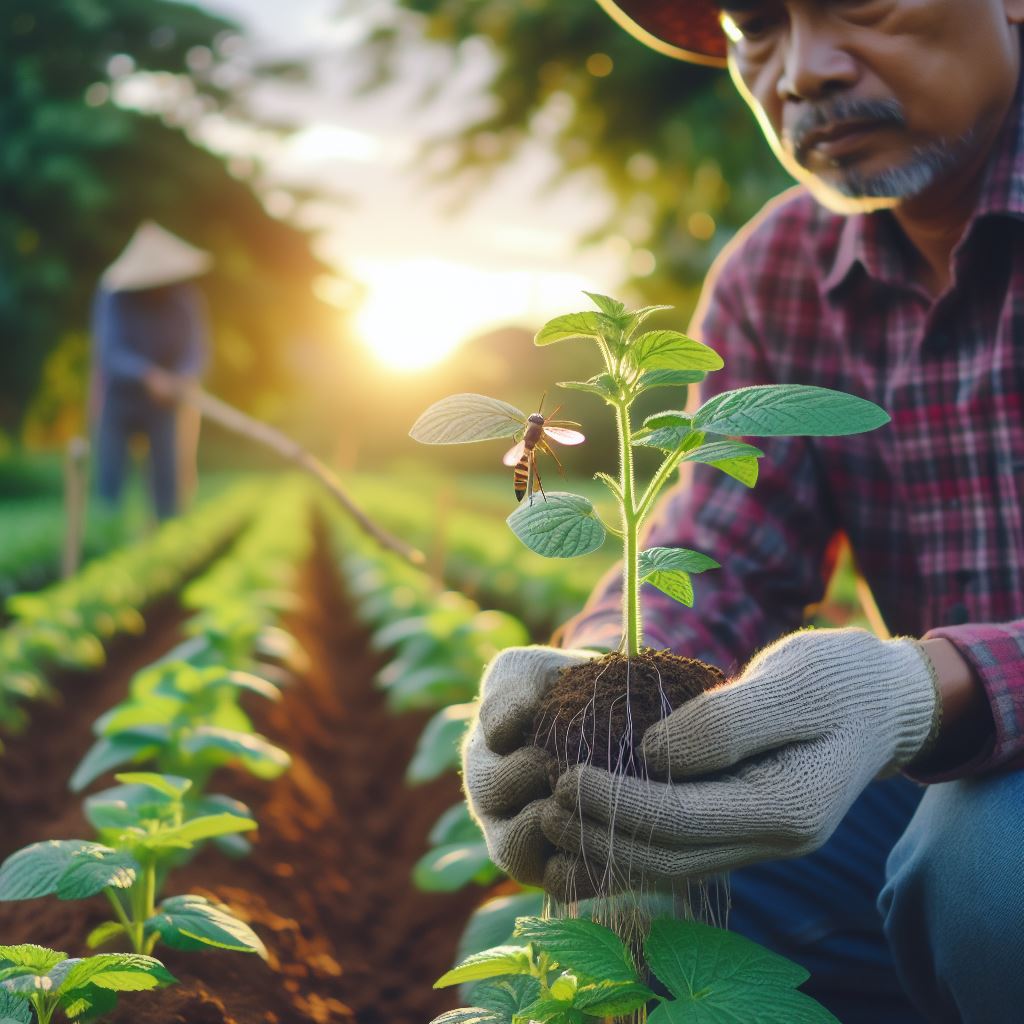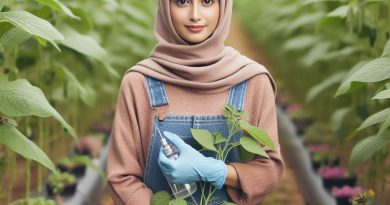IPM Strategies for Sustainable Farming
Last Updated on February 17, 2024
Introduction
In this blog section, we will discuss IPM strategies for sustainable farming. IPM, or Integrated Pest Management, is an approach that utilizes a combination of techniques.
Implementing IPM strategies is crucial for sustainable farming as it offers many benefits. By using IPM, farmers can reduce pesticide use, minimize harm to beneficial organisms, and protect the environment.
IPM also helps to manage pests effectively while promoting crop health and reducing the spread of pesticide resistance. Furthermore, it improves food safety by minimizing pesticide residues and increases the overall sustainability of farming practices.
The implementation of IPM strategies requires a thorough understanding of pest biology, monitoring, and accurate pest identification.Through careful planning and regular evaluation, farmers can adopt targeted and effective pest control measures.
An important aspect of IPM is the use of biological control agents, such as predators or parasites, to control pests naturally.
IPM also encourages the use of cultural practices, like crop rotation or selecting pest-resistant varieties, to prevent pest infestations.Another critical component is the use of physical barriers and traps to reduce pest populations.
Ultimately, implementing IPM strategies not only benefits the environment and public health but also helps farmers achieve long-term profitability.
Understanding IPM
IPM, which stands for Integrated Pest Management, is a sustainable approach to farming that focuses on prevention, monitoring, and control of pests.
Definition and principles of IPM
IPM is a holistic and environmentally friendly method that combines different pest management strategies to minimize damage to crops.
Components of IPM
1. Biological control methods
- Introduction of natural predators or parasites to control pest populations.
- Use of beneficial insects like ladybugs or nematodes to prey on pests.
2. Cultural practices
- Crop rotation to disrupt pest life cycles and reduce their population.
- Planting resistant crop varieties to decrease susceptibility to pests.
3. Chemical interventions
- Limited and strategic use of pesticides only when necessary.
- Selection of low-toxicity pesticides to minimize harm to beneficial organisms.
4. Monitoring and scouting techniques
- Regular monitoring of crops for pest populations and damage.
- Scouting to identify and assess potential pest threats.
In essence, IPM is an effective and sustainable approach to farming that balances pest control and ecological considerations. By understanding and implementing the different components of IPM, farmers can minimize crop damage while reducing reliance on chemical pesticides.
The integration of biological control methods, cultural practices, chemical interventions, and monitoring techniques is key to successful IPM implementation and long-term agricultural sustainability.
Benefits of IPM for Sustainable Farming
Integrated Pest Management (IPM) is a sustainable approach to farming that emphasizes the use of multiple strategies to control pests while minimizing harm to the environment.
By reducing reliance on chemical pesticides, preserving beneficial insect populations, preventing pest resistance, and conserving natural resources, IPM offers numerous benefits for sustainable farming.
Reduced use of chemical pesticides
- Chemical pesticides have detrimental effects on the environment and human health.
- IPM focuses on alternative pest control methods, such as biological control and cultural practices.
- By reducing chemical pesticide use, IPM minimizes the risk of pesticide contamination in soil and water.
Preservation of beneficial insect populations
- Beneficial insects play a crucial role in controlling pest populations naturally.
- IPM encourages the preservation and enhancement of beneficial insect habitats.
- This approach helps maintain a balanced ecosystem, reducing the need for pesticide application.
Prevention of pest resistance
- Pests can develop resistance to pesticides over time, rendering them ineffective.
- IPM uses a combination of strategies, making it harder for pests to adapt and develop resistance.
- This approach prolongs the effectiveness of pest control methods and reduces the need for stronger chemicals.
Conservation of natural resources
- Traditional farming practices often lead to the depletion of natural resources.
- IPM promotes sustainable practices, such as crop rotation and soil conservation.
- By reducing chemical inputs and improving soil health, IPM helps preserve valuable resources for future generations.
Protection of the environment
- Chemical pesticides can harm non-target organisms and disrupt ecosystems.
- IPM aims to minimize these negative impacts by using targeted pest control methods.
- This approach helps protect biodiversity and maintain ecological balance on farmlands.
In all, IPM offers significant benefits for sustainable farming.
By reducing the use of chemical pesticides, preserving beneficial insect populations, preventing pest resistance, conserving natural resources, and protecting the environment, IPM promotes a holistic and environmentally friendly approach to pest management.
Implementing IPM strategies can lead to healthier crops, improved ecosystem resilience, and long-term sustainability in agriculture.
Read: Hop Harvesting for Craft Brewing
Successful IPM Strategies for Sustainable Farming
Crop Rotation and Diversification
Crop rotation involves planting different crops in the same field over different growing seasons to prevent the buildup of pests and diseases. Diversification refers to growing a variety of crops in the same area to reduce pest susceptibility and enhance natural pest control.
Use of Trap Crops
Trap crops are specific plants that attract pests away from cash crops. By planting trap crops strategically, farmers can prevent pest damage to their main crops, reducing the need for chemical pesticides.
Implementation of Physical Barriers or Barriers
Physical barriers, such as fences or nets, can be used to physically block pests from accessing crops. This method is especially effective in preventing larger pests like rabbits or deer from causing damage.
Promotion of Natural Predators and Parasitoids
Encouraging the presence of natural predators and parasitoids on farms is crucial for sustainable pest control. These beneficial organisms feed on pests and help keep their populations in check. Planting flowering crops can attract these beneficial insects.
Disease and Weed Management Techniques
Effective disease management techniques include crop rotation, proper irrigation, planting disease-resistant varieties, and maintaining good field sanitation practices.
Weed management techniques, such as mulching and manual removal, can also help control weed growth.
Sensible Use of Chemical Pesticides as a Last Resort
While chemical pesticides may be necessary in some cases, they should be used as a last resort. Farmers should carefully assess the severity of pest infestations and explore other IPM strategies before resorting to chemical interventions.
Additionally, organic and low-toxicity pesticides should be preferred to minimize harm to the environment and human health.
Implementing these IPM strategies can lead to sustainable farming practices that reduce reliance on chemical pesticides and promote ecological balance on farms.
By prioritizing natural pest control methods, farmers can protect their crops while minimizing negative impacts on the environment.
Read: Grape Harvesting for Winemaking

Steps to Implement IPM on the Farm
- Conduct a thorough pest identification and monitoring to determine the specific pests present.
- Set economic thresholds for intervention, determining when pest populations reach a level that requires action.
- Select appropriate IPM methods based on the pest’s life cycle and behavior, considering biological, cultural, and chemical control options.
- Integrate different IPM components, combining various strategies to create a comprehensive pest management approach.
- Regularly evaluate and adjust IPM strategies to ensure effectiveness and sustainability over time.
Conduct a thorough pest identification and monitoring
Implementing Integrated Pest Management (IPM) begins with a careful examination of the farm to identify any existing or potential pests. This involves monitoring crops and their surroundings regularly.
By keeping an eye out for signs of pests and pests themselves, farmers can determine what pests are present and the extent of the infestation.
Set economic thresholds for intervention
Once pests have been identified, farmers need to establish economic thresholds for intervention. Economic thresholds represent the pest population level at which action needs to be taken to prevent significant economic losses.
By understanding the specific economic impact pests can have on their crops, farmers can determine when intervention is necessary and cost-effective.
Select appropriate IPM methods based on the pest’s life cycle and behavior
An essential step in implementing IPM is selecting the appropriate methods to control pests based on their life cycle and behavior. This includes considering biological, cultural, and chemical control options.
Biological controls, such as introducing beneficial predators, can help maintain pest populations naturally. Cultural controls involve altering farm practices to make the environment less favorable for pests.
Chemical controls should be used as a last resort and only when necessary.
Integrate different IPM components
One of the strengths of IPM is its ability to integrate different pest management techniques.
By combining various strategies, including biological, cultural, and chemical controls, farmers can create an effective and sustainable approach to pest management.
This integration maximizes control while minimizing risks to the environment and human health.
Regularly evaluate and adjust IPM strategies
IPM is an ongoing process that requires regular evaluation and adjustment of strategies.
Pest populations can change, new pests can emerge, and environmental conditions can vary over time. Therefore, farmers must regularly assess the effectiveness of their IPM strategies and make necessary adjustments.
This could involve revisiting economic thresholds, modifying control methods, or exploring new approaches based on research and developments in IPM techniques.
Generally, implementing IPM on the farm involves several key steps. Farmers must conduct thorough pest identification and monitoring, set economic thresholds for intervention, select appropriate IPM methods, integrate different components, and regularly evaluate and adjust their strategies.
By following these steps, farmers can effectively manage pests while minimizing their reliance on pesticides and promoting sustainable farming practices.
Read: Herb Harvesting: Preserving Flavor & Freshness
Case Studies and Success Stories
Successful implementation of IPM strategies in different farming systems
Case Study 1: Integrated Pest Management (IPM) in Organic Vegetable Farming
A small-scale organic vegetable farm in California successfully implemented IPM strategies to control pest populations without relying on synthetic pesticides.
By using cultural practices such as crop rotation, intercropping, and companion planting, the farmer created a balanced ecosystem that suppressed pests naturally.
This approach not only reduced the dependence on chemical inputs but also improved soil health and biodiversity on the farm.
Case Study 2: IPM in Rice Farming
In Southeast Asia, rice farmers faced significant pest challenges, but through the adoption of IPM strategies, they achieved remarkable success.
By using integrated pest management techniques such as timed planting, biological control agents, and pheromone traps, the farmers effectively managed pests while reducing production costs and minimizing pesticide residues.
This approach led to higher crop yields, improved farmer incomes, and reduced negative environmental impacts.
Case Study 3: IPM in Large-Scale Corn Production
In the United States, a large-scale corn producer implemented IPM strategies to combat insect pests that were threatening crop productivity.
By using pest-resistant corn varieties, implementing biological control methods, and regularly monitoring pest populations, the farmer optimized pest control while minimizing pesticide use.
This approach resulted in sustainable pest management, increased crop yield, and reduced production costs.
The positive outcomes and benefits achieved
Significant Reduction in Pest Damage
The successful implementation of IPM strategies has consistently resulted in a significant reduction in pest damage.
By combining various pest management tactics, farmers have effectively controlled and suppressed pest populations, leading to healthier crops and improved yields.
Reduced Reliance on Pesticides
IPM practices promote a reduction in pesticide use by integrating alternative pest control methods. This not only minimizes the presence of harmful chemicals in agricultural ecosystems but also reduces the risk of pesticide resistance development among pests.
Enhanced Environmental Sustainability
IPM strategies contribute to the overall sustainability of farming systems.
By relying on biological control agents, cultural practices, and crop rotation, farmers are able to maintain a balanced and resilient ecosystem that is less susceptible to pest outbreaks and environmental degradation.
Improved Farmer Health and Safety
By reducing pesticide use, farmers practicing IPM are exposed to fewer toxic chemicals, thereby improving their health and safety. IPM also promotes the use of protective equipment and proper handling of pest control products to further minimize health risks.
Sharing experiences and lessons learned
Continuous Learning and Adaptation
Successful implementation of IPM requires continuous learning and adaptation to local conditions. Farmers need to stay updated on the latest research, exchange knowledge and experiences, and be willing to experiment with new strategies.
Importance of Knowledge Exchange
Sharing success stories, challenges, and lessons learned among farmers, extension agents, and researchers is crucial for the wider adoption of IPM. Platforms such as farmer field schools, workshops, and online forums play a vital role in facilitating knowledge exchange.
Policy Support and Investment
Government policies and investments in IPM research and extension services are essential to promote the adoption of sustainable farming practices. Supportive policies can incentivize farmers to adopt IPM strategies and provide financial support for capacity building and infrastructure development.
In general, the successful implementation of IPM strategies in various farming systems has demonstrated its ability to achieve positive outcomes and benefits.
Through case studies and success stories, it is evident that IPM can effectively reduce pest damage, minimize pesticide use, enhance environmental sustainability, and improve farmer health and safety.
Sharing experiences and lessons learned are crucial for further promoting IPM adoption. With policy support and continuous investment, IPM can contribute to more sustainable and resilient farming practices globally.
Read: Orchard Fruit Storage: Best Practices
Conclusion
Integrated Pest Management (IPM) is a crucial approach for sustainable farming. It is essential for farmers to adopt IPM strategies to ensure the long-term viability of their farms.
Not only does IPM minimize the negative impacts on the environment, but it also improves farm profitability. By implementing IPM, farmers can reduce the reliance on chemical pesticides and instead focus on preventive measures.
This proactive approach leads to healthier crops, reduced pest populations, and better overall farm productivity. The use of IPM also promotes biodiversity and helps maintain a balanced ecosystem on the farm.
By minimizing the use of pesticides, IPM prevents the development of pesticide resistance in pests. This sustainable farming method also reduces the risk of chemical contamination in soil, water, and food.
Furthermore, adopting IPM strategies can result in cost savings for farmers in the long run. Although implementing IPM may require some initial investment and additional effort, the benefits far outweigh the challenges.
With increasing consumer demand for environmentally friendly and sustainable practices, adopting IPM can also enhance market opportunities for farmers.
By embracing IPM, farmers can achieve the dual goals of environmental stewardship and economic success in the farming industry.


